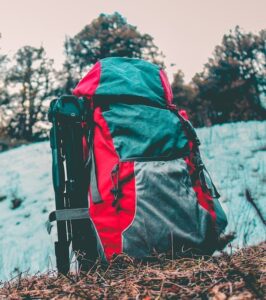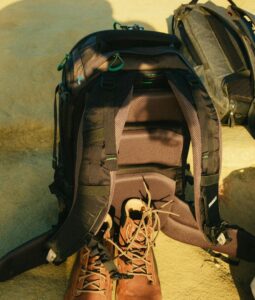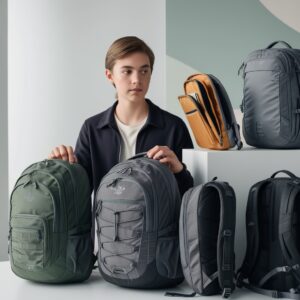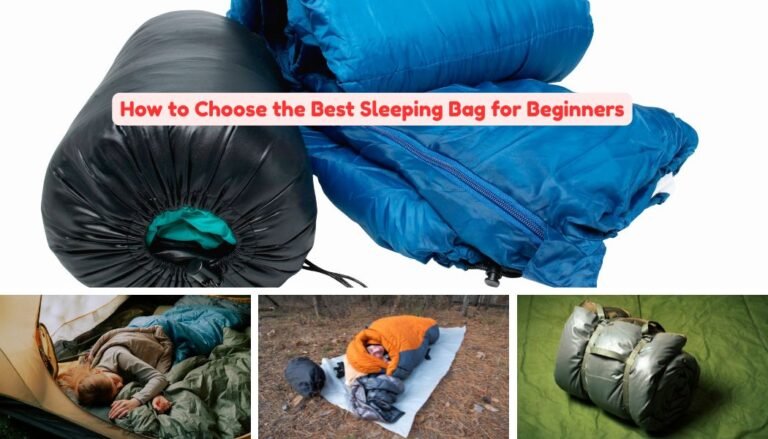Importance of Choosing the Right Backpack
Selecting the perfect backpack is no simple task. It requires a complete understanding of your needs, from the type of activities you’ll be engaging in to the specific features of the backpack itself. In this guide, I’ll walk you through everything you need to know to make the right decision. Whether you’re an outdoor enthusiast or just someone looking for a reliable everyday backpack, this article will give you all the essential information.
We’ll cover everything from types of backpacks, key features to look for, how to fit a backpack properly, and specific equipment needed. By the end of this detailed review, you’ll be equipped with the knowledge to confidently select the backpack that best suits your lifestyle and adventures.

Understanding Different Types of Backpacks
Choosing the right backpack starts with knowing what type of backpack suits your needs. Not every backpack is designed for the same purpose, and picking one based solely on looks or size can leave you dissatisfied in the long run. Let’s break down the most common types of backpacks and when to use them.
Daypacks
Daypacks are small, lightweight backpacks typically designed for short trips or day hikes. They usually range from 15 to 30 liters in capacity, offering just enough space for the essentials like water, snacks, an extra layer of clothing, and maybe a camera. What makes daypacks appealing is their simplicity and the ease of use in minimalistic environments.
Hiking Backpacks
When you’re heading into the wilderness for more than just a few hours, you’ll want a hiking backpack. These packs range between 30 to 75 liters, often with advanced features like adjustable suspension systems, multiple compartments, and attachment points for gear. Their primary purpose is to carry large loads comfortably over long distances.
Travel Backpacks
Travel backpacks are tailored for people on the go, especially those looking to replace a suitcase with a more versatile option. They typically include a large main compartment, quick-access pockets, and the ability to fit neatly in overhead compartments on planes. Look for travel backpacks with lockable zippers and compression straps to keep your contents organized and secure.
Tactical Backpacks
Originally designed for military use, tactical backpacks have gained popularity due to their durability and modular features. These backpacks come equipped with MOLLE (Modular Lightweight Load-carrying Equipment) systems for attaching external pouches and gear. They are built tough, often featuring reinforced stitching and water-resistant materials.
Hydration Packs
Hydration packs are specialized for those who need a constant water supply during their activities, such as runners or cyclists. They come with a built-in water reservoir or bladder and typically have minimal storage beyond that. Their lightweight design ensures that you stay hydrated without the bulk of a larger pack.
Laptop Backpacks
Laptop backpacks are essential for students, professionals, and digital nomads who need a dedicated space for their tech. These packs are designed with padded compartments to safely store a laptop and often include sections for chargers, accessories, and other work essentials.
Camera Backpacks
For photographers, a camera backpack is a necessity. These are designed with padded compartments specifically for camera bodies, lenses, and accessories, ensuring that your gear stays protected. Look for customizable dividers and easy access points so that you can reach your camera without taking off the whole bag.
Key Features to Consider
Now that we’ve covered the different types of backpacks, it’s time to dig into the features that make a backpack not only functional but ideal for your needs. Each element serves a purpose, and understanding these will help you avoid buyer’s remorse.
Capacity
Choosing the right capacity depends heavily on your intended use. Daypacks usually range from 15-30 liters, hiking backpacks from 30-75 liters, and larger expedition backpacks can exceed 75 liters. Capacity influences how much you can carry, so think ahead about your trips and pack light when possible.
Compartments and Organization
How you organize your backpack can make or break your experience. Look for backpacks with multiple compartments to help you distribute the weight of your gear and access specific items easily. Top-loading backpacks are great for volume while front-loading packs provide better access.
Weight Distribution
Proper weight distribution is essential to avoid discomfort and strain. Backpacks with internal frames help keep the weight close to your body’s center of gravity. Hip belts and shoulder straps should also play a role in shifting the load from your back to your hips.

Padding and Ventilation
Comfort is key, especially on long treks or in hot weather. Well-padded shoulder straps, hip belts, and back panels are critical in reducing pressure points. Additionally, some packs feature mesh or ventilated designs to keep your back cool and minimize sweat buildup.
Weather Resistance
Many backpacks offer water-resistant materials, but if you plan to spend significant time outdoors, look for a fully waterproof backpack or one that includes a rain cover. Coated zippers and sealed seams are additional bonuses for weatherproofing your pack.
Accessibility
Whether you’re on the trail or navigating an airport, quick access to your gear is essential. Look for backpacks with side zippers, front pockets, and easy-to-reach compartments to minimize the time spent rummaging through your belongings.
Backpack Frames: The Backbone of Support
When it comes to backpacks, the frame plays a crucial role in providing structure, support, and comfort. Choosing the right type of frame can make a significant difference, especially when you’re carrying heavier loads or covering long distances. Let’s dive into the different types of backpack frames, their advantages, and which one might be right for your specific needs.
Internal Frames
Internal frame backpacks are designed with the frame hidden inside the pack. These backpacks are built to keep the load close to your body, which helps with stability, especially in uneven terrain. The snug fit provided by an internal frame ensures better weight distribution, making it easier to carry heavier loads over long distances.
Advantages of Internal Frames:
Enhanced Stability: The close fit makes these backpacks ideal for activities like climbing or hiking, where balance is key.
Compact Design: Internal frames tend to be more compact, allowing for better maneuverability in tight spaces or rugged landscapes.
Load Distribution: They offer superior weight distribution, transferring much of the load to your hips and reducing strain on your shoulders and back.
When to Choose an Internal Frame Backpack:
If you’re going on multi-day hikes, climbing, or trekking through uneven terrain, an internal frame backpack is your best bet. Its design keeps your gear secure and balanced, allowing you to focus on the adventure without having to worry about instability.

External Frames
External frame backpacks, on the other hand, feature a visible frame that extends beyond the fabric of the pack. These packs were traditionally used for heavy loads and were popular among long-distance hikers and campers. While they’re not as common today, external frames still have a place for certain types of adventures.
Advantages of External Frames:
Superior Ventilation: Because the pack sits farther away from your back, there’s better airflow, making external frames a great option for hot climates.
Higher Load Capacity: These backpacks are often better suited for carrying larger, bulkier items, making them ideal for extended trips that require more gear or packing out game.
Customizable: External frame backpacks usually have more attachment points for gear like sleeping bags or tents, giving you the flexibility to carry more equipment.
When to Choose an External Frame Backpack:
If you’re embarking on a trip where ventilation is key or if you need to carry bulky gear like a tent, sleeping bag, cooking equipment, or game, an external frame pack is a great choice. They’re also a solid option for beginners, as their structure can help manage heavier loads.
Frameless Backpacks
Frameless backpacks are exactly what they sound like, packs without any built-in frame. These are the lightest and most compact type of backpacks, popular among ultralight hikers and minimalists. However, without a frame, the pack doesn’t offer much in terms of support or weight distribution, which can be problematic for heavy loads.
Advantages of Frameless Backpacks:
Lightweight and Flexible: Frameless packs are perfect for those who prioritize reducing weight and need maximum flexibility.
Packable: Because they’re so flexible, frameless backpacks can be easily packed into larger luggage, making them a good choice for travel.
Cost-Effective: Generally, frameless backpacks are less expensive due to their simple design and fewer materials.
When to Choose a Frameless Backpack:
Frameless backpacks are ideal for shorter hikes, day trips, or when you don’t need to carry a lot of gear. They’re also popular among ultralight hikers who meticulously plan their load to stay within the comfort zone of a frameless design.

Choosing the Right Frame for You
Selecting the right backpack frame depends on your specific needs and the type of activity you’re engaging in. If stability and support are priorities for you, especially over long distances or with heavy loads, an internal or external frame will serve you well. However, if you’re a minimalist or ultralight hiker, a frameless pack offers the flexibility and lightness you need. In any case, ensure the pack fits your body type and load requirements to maximize comfort and efficiency on your adventures.
How to Properly Fit a Backpack
Selecting the right size backpack isn’t enough; you also need to make sure it fits your body properly. The last thing you want is to be halfway through a hike, feeling like your pack is working against you.
Torso Length
Backpacks are typically designed based on torso length, not your overall height. Measure your torso from the base of your neck to your hip bones to find the correct size. A properly fitted pack should sit comfortably against your back without sagging.
Hip Belt and Shoulder Straps
The hip belt plays an essential role in weight distribution. Make sure it sits snugly around your hips, with the majority of the pack’s weight resting on your pelvis, not your shoulders. The shoulder straps should curve naturally without cutting into your neck.
Load Adjustment Straps
Load adjustment straps help you customize how the weight is distributed, so use them! You can cinch the pack closer to your body or loosen it depending on the terrain and your comfort level. Don’t forget to adjust the sternum strap to keep everything in place.
Fitting for Different Activities
Keep in mind that how you fit a backpack can vary depending on your activity. For hiking, you’ll want a pack that keeps the weight balanced and secure, while a casual backpack used in the city might prioritize comfort over performance.
Choosing the Right Materials
Backpack material significantly impacts durability, weight, and water resistance. It’s important to balance these factors based on your needs.
Nylon vs. Polyester
Nylon is widely used for its strength and durability, making it ideal for hiking and heavy-duty backpacks. Polyester is typically lighter and more affordable but is less durable in harsh environments, becoming frayed. Understanding the trade-offs can help you choose wisely.
Durability and Weight
The denier (D) of the fabric indicates its durability. A higher of number denier means a tougher material, though it can also add weight. For everyday use, a lower denier (300-600D) is usually sufficient, but for backcountry hiking or travel, opt for a higher denier (800D+).
Water-Resistant Coatings
Backpacks with water-resistant coatings are essential for anyone spending time outdoors. Look for backpacks with PU (polyurethane) or silicone coatings, which offer strong water resistance without adding too much weight.
Required Equipment for Backpack Selection
Selecting the right backpack requires more than just the bag itself. Some additional equipment can greatly enhance your experience.
Cloth Measuring Tape
This simple tool can help you measure your torso length to ensure you get the right size. Many outdoor stores will measure you so that you can prevent future discomfort.
Rain Cover
If your backpack isn’t fully waterproof, a rain cover is a must-have. It’s a lightweight, inexpensive way to protect your belongings in case of sudden downpours.
Compression Straps
Compression straps help keep your load tight and stable, reducing shifting as you move, which could affect your balance. They’re especially useful on larger backpacks when carrying bulky or uneven loads.
Hydration System
For outdoor activities, integrating a hydration system into your backpack allows you to stay hydrated without stopping. Look for backpacks with built-in hydration sleeves or bladders that are compatible with hydration reservoirs.
Common Mistakes When Choosing a Backpack
It’s easy to make mistakes when selecting a backpack. Here are the most common ones and how to avoid them.
Overlooking Weight Distribution
Failing to consider weight distribution is one of the most common mistakes. Always ensure that the pack’s design supports a balanced load, especially for longer trips or heavier loads.
Choosing Based on Appearance
Aesthetics can be deceiving. Don’t pick a backpack solely based on its design or color. Focus on functionality, fit, and features first.
Ignoring Specialized Needs
Some backpacks are designed for specific activities. Ignoring these specialized features can lead to discomfort or even injury. Always consider what the pack is intended for before purchasing.
Final Thoughts: The Backbone of Every Adventure
Choosing the right backpack is more than just picking something to carry your gear; it’s about finding the right companion for your adventures. A well-selected backpack can enhance your experience, whether you’re hiking through rugged landscapes or navigating a busy city. Take your time, evaluate your needs, and ensure that the backpack you select will serve you well for many years to come.

FAQ Section
What’s the ideal capacity for a day pack?
For most day trips, a 20-30 liter day pack should suffice. It has enough room for water, food, and a few essentials without being overly bulky.
How should I pack my backpack to maximize comfort?
Distribute the heaviest items closest to your back and towards the middle of the pack. Keep lighter items at the bottom and top, and balance the weight evenly between the sides. This helps maintain stability and reduces strain on your body.
Should I get a backpack with a frame?
Framed backpacks offer better weight distribution for heavy loads or long trips. If you’re going on short hikes or using the pack casually, a frameless option might work better.
How do I know which size backpack to get?
Measure your torso length and ensure the backpack’s size aligns with it. Always try on the backpack with a load to see how it feels.
How do I waterproof my backpack?
You can either buy a backpack made from waterproof materials or use a rain cover. Additionally, using dry sacks or a garbage bag inside can help keep your gear dry.
What’s the difference between top-loading and front-loading backpacks?
Top-loading backpacks have a single opening at the top, maximizing space while front-loading backpacks have zippers that allow easy access to contents.
What is a hydration-compatible backpack, and do I need one?
A hydration-compatible backpack has a designated sleeve or pocket for a water bladder, with a hose port for easy access. If you hike, bike, or do other outdoor activities where you need to stay hydrated without stopping, it’s a highly convenient feature.
Disclaimer: This blog post contains affiliate links




